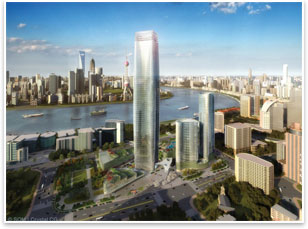SOM on Fast Company’s 50 Most Innovative List
by Jennifer Brite
 Summary: Having completed more than 10,000 projects and at work on 1,320 more, SOM certainly has garnered its share of praise. Now it has been named one of Fast Company magazine’s World’s 50 Most Innovative Companies of 2009. Best known for complex mixed-use projects that involve residential, hospitality, and civic construction, the architecture, the urban design, engineering, and architecture firm has an enviable portfolio stretching over 73 years that includes superlatives such as the design and construction of America’s tallest building, the Sears tower, and the world’s soon to be tallest, the BURJ Dubai, as well as Pearl River Tower, slated to be the planet’s most energy-efficient high-rise, and probably the most controversial project of all, the Freedom Tower. Summary: Having completed more than 10,000 projects and at work on 1,320 more, SOM certainly has garnered its share of praise. Now it has been named one of Fast Company magazine’s World’s 50 Most Innovative Companies of 2009. Best known for complex mixed-use projects that involve residential, hospitality, and civic construction, the architecture, the urban design, engineering, and architecture firm has an enviable portfolio stretching over 73 years that includes superlatives such as the design and construction of America’s tallest building, the Sears tower, and the world’s soon to be tallest, the BURJ Dubai, as well as Pearl River Tower, slated to be the planet’s most energy-efficient high-rise, and probably the most controversial project of all, the Freedom Tower.
“We chose SOM because we were looking for firms with the greatest impact. While many others did innovative projects, the sheer breadth and scale of SOM's work gave it the edge,” says Linda Tischler, senior writer at Fast Company. “We were impressed at their skill in adapting to local cultures, whether they be the searing heat of the Arabian peninsula or the earthquake hazards in California, and turning those environmental challenges into compelling design.”
In fact, the firm’s buildings can be found in more than 50 countries, recently most notably in the Middle East and China. According to Craig Hartman, FAIA, design partner at the firm’s San Francisco office, the ability to work within different cultures effectively starts in the hiring process. At his 200-person office alone—SOM has two other major offices in Chicago and New York and well as smaller ones in Washington, D.C., London, and Shanghai—more than 10 languages are spoken, and last year’s crop of interns included students from Beijing, Santiago, Chile, Buenos Aires, and Paris. TJ Gottesdiener, FAIA, managing partner of the New York office, seconds this idea, saying he’s never once had to hire a translator when talking to a foreign client, but instead has always been able to find an architect in his office who can communicate in that person’s native tongue, which he says positively affects the design process.
“No matter where we work, we have to be certain we are creating an appropriate response to the local conditions,” Gottesdiener says. “We don’t want people to look at a building and say ‘that looks like a Skidmore building.’ We have to understand the urban issues and the client's needs to make sure our projects are relevant, regardless of where they are located.”
Keeping ahead of the curve also means investing in new technologies and being able to adapt quickly. In 2005, the firm set up a collaboration with Autodesk to beta test Revit to facilitate the design of the Freedom Tower and reorganized architects working on the project into thematic groups (such as curtain wall and public spaces) rather than separating them into design and technical camps in order to make the best use of the new software.
More recently, SOM, along with the Rensselaer Polytechnic Institute in Troy, N.Y., established the Center for Architecture, Science, and Ecology (CASE) at the firm’s New York office. CASE allows 15 master’s and doctoral degree candidates to work alongside building professionals and post-doctoral researchers to develop new construction strategies with an emphasis on energy efficiency and sustainability. One of the program’s current projects involves developing a new way to harness wind power atop aerodynamically shaped buildings that could yield up to 150 percent greater efficiency than current systems. In fact, SOM expects that 75 percent of its buildings being built in the next two years will have an eco-friendly component.
“Ecology has always been at the core of our practice at SOM, with the idea that cities and architecture are inseparable from their natural and their cultural landscapes,” says Hartman. ”Nat Owings talked about that fundamental relationship long before today’s understanding of the impact our patterns of settlement have on the environment and global climate change. ‘Greenness’ remains a central part of our core ethos, and happily, it is also now asked for by the public.”
Hartman goes on to say that despite the nation’s current economic troubles, he feels SOM is primed for a bright future. As a private partnership, it is not beholden to banks, a strong asset in today’s financial crisis. The firm has also begun to focus more on infrastructure and transportation, two areas that are expected to see massive growth. But ultimately it’s the architects themselves who make any firm run, according to Gottesdiener.
“Succession planning is part of our culture,“ says Gottesdiener. “I know that I’m not going to be the guy closing the lights on this firm. Each generation of partners is responsible for identifying and grooming the next generation. We try to give people as much opportunity to grow as possible.”
|



